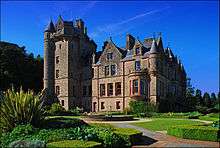Architecture of Belfast
The architecture of Belfast comprises many styles of architecture ranging from Georgian through to state-of-the-art modern buildings like the Waterfront Hall and Titanic Belfast. The city's beautiful Victorian and Edwardian buildings are notable for their display of a large number of sculptures. Many of Belfast's Victorian landmarks, including the main Lanyon Building at Queens University in 1849, were designed by Sir Charles Lanyon.
Chronology and Styles
Belfast became a substantial settlement in the 17th century after being established as a town by Sir Arthur Chichester,.[1] None of the buildings from Belfast’s first century as a market town on the river Farset survive today. The only significant structures in those early years from 1613 would have been a castle established by Sir Arthur Chichester, and the parish church at the foot of High Street, where a ‘chapel of the ford’ had been erected by 1306, and where St George’s church now stands.
-

Belfast Castle
(1811–1870; Grade B+)
Georgian
-

Clifton House
(1771-1774; Grade A) -

The Exchange and Assembly Rooms
(1769)
Remodelled in 1845
Victorian
-

Botanic Gardens Palm House
(1839–1840) -

Lanyon Building
(1849) -

16 Victoria Street
(1852; Grade B) -

Union Theological College
(1853; Grade A) -

The Custom House
(1856) -

Ulster Hall
(1859-1862; Grade B1)
Renovated 2009 -
The Headline Building
(1863) -

Clarence House
(1867) -

The Scottish Provident Institution
(1899-1902)
Edwardian and 20th century
-

Belfast City Hall
(1898–1906; Grade A) -

Parliament Buildings
(1922–1932; Grade B+) -
Windsor House
(1975) -

Belfast City Hospital Tower
(1986) -

Waterfront Hall
(1995-1997) -

BT Riverside Tower
(1998) -
_-_geograph.org.uk_-_1249088.jpg)
Belfast Hilton
(1998)
21st century
In 2011 and 2012 Belfast saw the creation of two buildings described as "two of the most stunning new British buildings of the century",[2] namely the Lyric Theatre (2011) by Irish architects O’Donnell and Tuomey and the Belfast MAC (2012) by local architectural practice Hackett Hall McKnight. In contrast, the new boat-shaped Titanic Museum (2012) was described by The Telegraph as "startlingly inane".[2]
-

Obel Tower
(2006-2011) -
_-_geograph.org.uk_-_716074.jpg)
Victoria Square
(2008) -
The Boat
(2010) -

Titanic Belfast
(2012) -
The MAC
(2012) -
_-_geograph.org.uk_-_1716262.jpg)
Lanyon Plaza
(2014)
Parks and gardens
See also
References
Notes
- ↑ "History of Belfast Castle". Tourism and venues. Belfast City Council. 2014. Retrieved 19 May 2014.
- 1 2 "Belfast: rising from the ruin of the Troubles". The Telegraph. 25 April 2012. Retrieved 27 October 2014.
External links
- Archiseek - Belfast Architecture
- Future Belfast
- Culture NI - The Architecture of Belfast
- University of Ulster Belfast School of Architecture
- Queen's University School of Planning Architecture and CivilEngineering (SPACE)